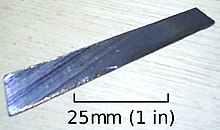
Back Uraan-238 AF يورانيوم-238 Arabic Уран-238 Bulgarian Urani 238 Catalan Uran-238 Czech Uran-238 Danish Uran-238 German Uranio-238 Spanish اورانیوم-۲۳۸ FA Uranium 238 French
 10 gram sample | |
| General | |
|---|---|
| Symbol | 238U |
| Names | uranium-238, 238U, U-238 |
| Protons (Z) | 92 |
| Neutrons (N) | 146 |
| Nuclide data | |
| Natural abundance | 99.2745% |
| Half-life (t1/2) | 4.468×109 years |
| Isotope mass | 238.05078826 Da |
| Spin | 0 |
| Parent isotopes | 242Pu (α) 238Pa (β−) |
| Decay products | 234Th |
| Decay modes | |
| Decay mode | Decay energy (MeV) |
| alpha decay | 4.267 |
| Isotopes of uranium Complete table of nuclides | |
Uranium-238 (238
U
or U-238) is the most common isotope of uranium found in nature, with a relative abundance of 99%. Unlike uranium-235, it is non-fissile, which means it cannot sustain a chain reaction in a thermal-neutron reactor. However, it is fissionable by fast neutrons, and is fertile, meaning it can be transmuted to fissile plutonium-239. 238U cannot support a chain reaction because inelastic scattering reduces neutron energy below the range where fast fission of one or more next-generation nuclei is probable. Doppler broadening of 238U's neutron absorption resonances, increasing absorption as fuel temperature increases, is also an essential negative feedback mechanism for reactor control.
Around 99.284% of natural uranium's mass is uranium-238, which has a half-life of 1.41×1017 seconds (4.468×109 years, or 4.468 billion years).[1] Due to its natural abundance and half-life relative to other radioactive elements, 238U produces ~40% of the radioactive heat produced within the Earth.[2] The 238U decay chain contributes six electron anti-neutrinos per 238U nucleus (one per beta decay), resulting in a large detectable geoneutrino signal when decays occur within the Earth.[3] The decay of 238U to daughter isotopes is extensively used in radiometric dating, particularly for material older than approximately 1 million years.
Depleted uranium has an even higher concentration of the 238U isotope, and even low-enriched uranium (LEU), while having a higher proportion of the uranium-235 isotope (in comparison to depleted uranium), is still mostly 238U. Reprocessed uranium is also mainly 238U, with about as much uranium-235 as natural uranium, a comparable proportion of uranium-236, and much smaller amounts of other isotopes of uranium such as uranium-234, uranium-233, and uranium-232.[4]
- ^ Mcclain, D. E.; Miller, A. C.; Kalinich, J. F. (December 20, 2007). "Status of Health Concerns about Military Use of Depleted Uranium and Surrogate Metals in Armor-Penetrating Munitions" (PDF). NATO. Archived from the original (PDF) on April 19, 2011. Retrieved November 14, 2010.
- ^ Arevalo, Ricardo; McDonough, William F.; Luong, Mario (2009). "The K-U ratio of the silicate Earth: Insights into mantle composition, structure and thermal evolution". Earth and Planetary Science Letters. 278 (3–4): 361–369. Bibcode:2009E&PSL.278..361A. doi:10.1016/j.epsl.2008.12.023.
- ^ Araki, T.; Enomoto, S.; Furuno, K.; Gando, Y.; Ichimura, K.; Ikeda, H.; Inoue, K.; Kishimoto, Y.; Koga, M. (2005). "Experimental investigation of geologically produced antineutrinos with KamLAND". Nature. 436 (7050): 499–503. Bibcode:2005Natur.436..499A. doi:10.1038/nature03980. PMID 16049478. S2CID 4367737.
- ^ Nuclear France: Materials and sites. "Uranium from reprocessing". Archived from the original on October 19, 2007. Retrieved March 27, 2013.